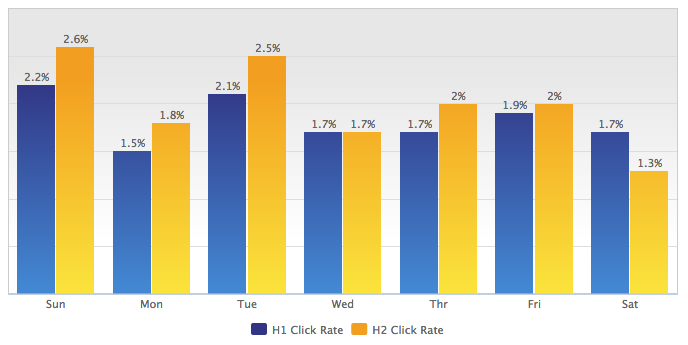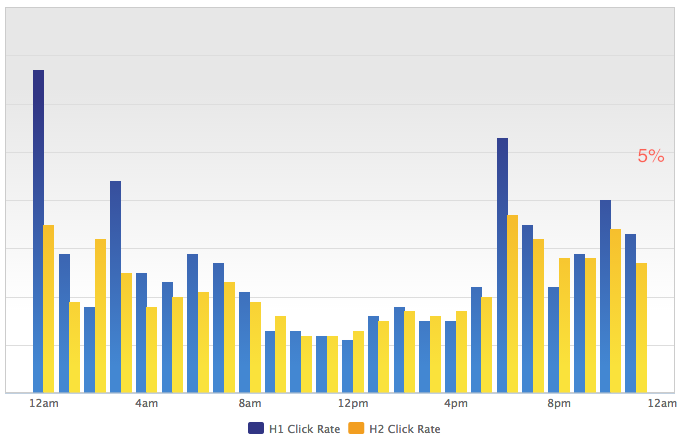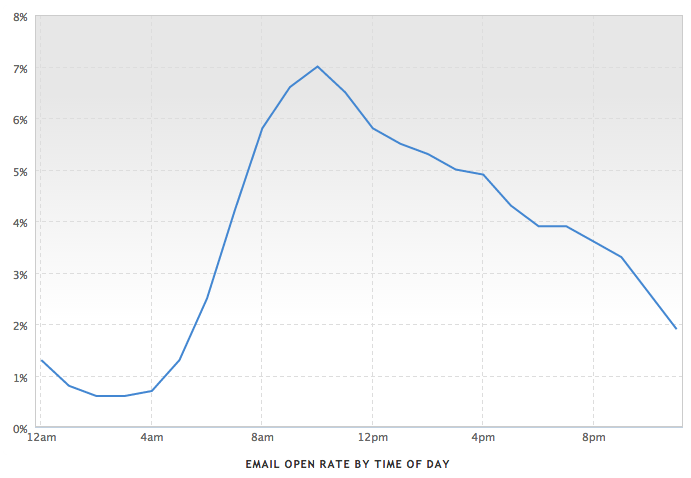Email Open and Click Rates By Day and Time
August 2013 -- Email marketing service group MailerMailer analyzed data from over 1.4 billion email messages, comprising over 70,000 newsletter campaigns, sent between January 1, 2012 and December 31, 2012 for the 13th Annual Email Marketing Metrics Report examining email marketing trends and climate.
When looking at how scheduling affects open and click rates, it's important to remember that each list acts differently, so individual results will vary. For this time period and the campaigns analyzed across industries, the findings show:
Open Rates By Day
Open rate measures how many people viewed or opened a specific message.
-
During the first half of the year (H1), open rates peaked on Tuesdays and Wednesdays at 10.7%; The second half of the year (H2) experienced its highest open rate (10.6%) on Tuesdays.
-
Of the weekday open rates, Thursdays were slightly depressed.
-
Weekends resulted in the lowest open rates, with Sunday yielding 8.5% during H1 and Saturday seeing 6.1% opens during H2.
U.S. EMAIL OPEN RATES BY DAY
(H1 = FIRST HALF of 2012 / H2 = SECOND HALF of 2012)
.png)
Source: MailerMailer, August 2013
Click Rates By Day
Click rate indicates response to a specific email message. MailerMailer calculates this statistic based on unique clicks within a message.
-
For click rates, the highest response stats occurred on Sundays (2.2% and 2.6% during H1 and H2, respectively), followed by Tuesdays.
-
During the first half of the year, the lowest click rate occurred on Mondays (1.5%). However, during the second half of the year, Saturday resulted in the lowest click rate (1.3%).
U.S. EMAIL CLICK RATES BY DAY
(H1 = FIRST HALF of 2012 / H2 = SECOND HALF of 2012)

Source: MailerMailer, August 2013
Open Rates by Time Scheduled
-
In general, email messages scheduled for delivery between early evening and early morning led to better open rates. Messages scheduled for delivery at lunch time fared worst.
-
H1 open rates peaked at 20.4% for messages scheduled for 12am. During the second half of the year, open rates reached a high of 15.1% for message scheduled for 8pm and 11pm.
-
For both halves of 2012, emails experienced their lowest open rates (5.5% and 7.9% respectively) for messages scheduled for 12pm.
U.S. EMAIL OPEN RATES BY DELIVERY TIME SCHEDULED
(H1 = FIRST HALF of 2012 / H2 = SECOND HALF of 2012)

Source: MailerMailer, August 2013
Click Rates by Time Scheduled
-
Click rates responded similarly to open rates; the highest click rates were for messages scheduled between early evening and morning time.
-
During the first half of the year, the highest click rate occurred for messages scheduled for 12am (6.7%). For the second half of the year, emails scheduled for 6pm achieved the highest click rate of 3.7%.
-
The lowest click rate of 1.1% were seen for messages scheduled for delivery at noon in H1, while H2 saw the low rate of 1.2% for messages scheduled for 10am and 11am.
U.S. EMAIL CLICK RATES BY DELIVERY TIME SCHEDULED
(H1 = FIRST HALF of 2012 / H2 = SECOND HALF of 2012)

Source: MailerMailer, August 2013
Email Open Rates By Time of Day
-
Open rate climbed rapidly after about 4am, reaching a maximum of 7% at 10am.
-
After 10am, open rates declined steadily throughout the rest of the day.
-
In general, emails were more likely to be opened during normal business hours, specifically about 8am to 5pm.
U.S. EMAIL CLICK RATES BY TIME OF DAY

Source: MailerMailer, August 2013
About: This report is based on data from over 1.4 billion email messages, comprising over 70,000 newsletter campaigns, sent between January 1, 2012 and December 31, 2012 by MailerMailer. Click rate statistics excluded emails with no links and subject line metrics omitted those with fewer than four characters. The 35 industries in this report have been assigned to MailerMailer customers based on fixed, internal criteria. Industries were assigned based on nature, rather than type, of business. For instance, a sporting goods store was placed under Sports, Fitness and Recreation, rather than generalized retail. Only customers with a significant list size (over 25 list members) were presented within this report.
It’s important to remember that each list acts differently, so individual results will vary.
Source: MailerMailer, 13th Annual Email Marketing Metrics Report, accessed Sept. 17, 2013.





